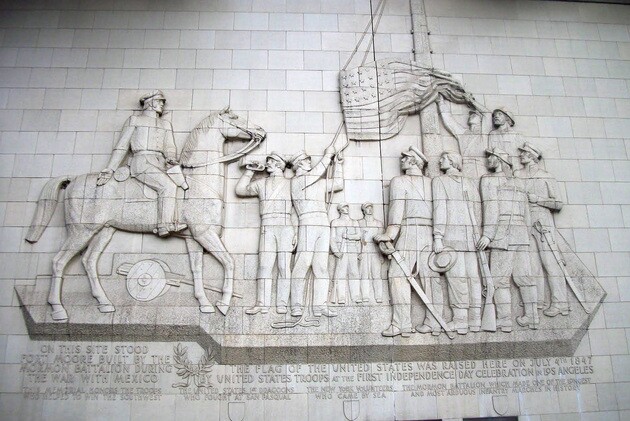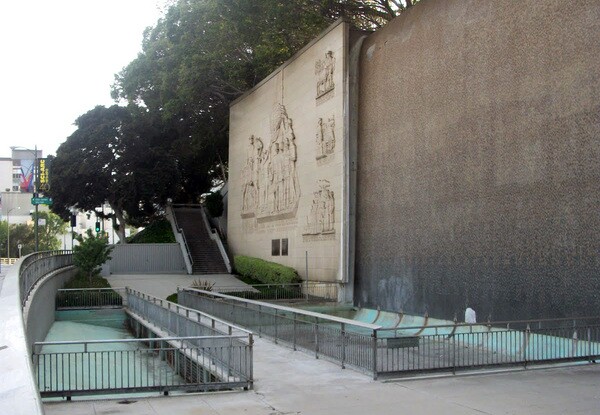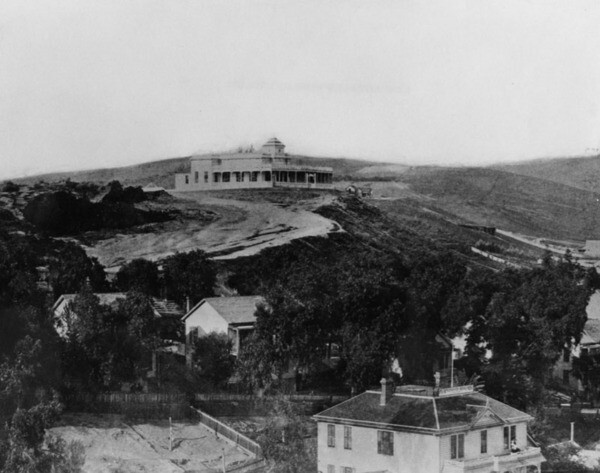The Many Lives of Fort Moore Hill: The Shifting and Shrinking of a Los Angeles Icon

It's scary to get there. I park on the shaky North Hill Street overpass overlooking the 101 Freeway, and take a short walk north. Besides a couple of transients, I am the only person foolish enough to not be in a car. I am quickly at the side of a steep, shaved hill, standing under a 45-foot terra cotta bas-relief monument as cars whizz by. Puzzled into the monument is a cartoon-like scene of soldiers raising a flag as a commander watches on horseback. A trio of smaller scenes show a farmer, a locomotive and a family standing in front of a water and power plant. Next to the bas-relief are a towering water fountain, long dry and rusted, and a tall pylon behind a lofty metal flag pole where nothing flies.
This is the Fort Moore Pioneer Memorial, a small memorial park that seems to be remembered by no one except perhaps the little animals and desperate people who use it as a place of rest. On each side of the monument there are a series of steep, narrow steps. Against my better judgment I go up. It smells strongly of feces with discarded t-shirts and forties all around. Soon, I am at the flat top of the hill peering through a fence. All I see is a hilltop of dirt, and what looks like abandoned, ultra-modern buildings. I do not know I am actually looking at a performing arts high school. I do not know that I am on top of a hill that once stretched from Temple Street all the way to Cesar Chavez Avenue.
Creeped out, I run down the steps back to street level. It is windy and the sky is bright blue and it is then that I notice the breathtaking view. Over the cars, above the smell of decay and gasoline, I see downtown Los Angeles stretched below me. Most importantly, I see old Los Angeles, the small pueblo that is now a tourist trap. I can see buildings on Olvera Street and the outline of the gazebo in the Plaza. The Plaza was where the Spanish and Mexican aristocrats made their homes and often danced into the night, until they were slowly suffocated into the American dream.
I will soon learn that this is a hill where the white man watched. Where they built a Fort, celebrated L.A.'s first Fourth of July, buried their dead, built their finest homes and newest schools, and endlessly searched for even more treasure, until the very ground they stood on impeded their march toward the future.

"Independence" Day
"Boom insanity blighted not only people's good judgment but their humanity and sense of justice."-- Horace Bell, "The Reminiscence of a Ranger"
The Mexican-American war began in 1846 with the American annexation of Texas. It officially ended in May of 1848 with the Treaty of Guadalupe Hidalgo, in which Mexico ceded the Southwest, including all of California, although most of the fighting had ended with the signing of the Treaty of Cahuenga in January, 1847. During the war, battles with local "Californios" in Los Angeles had led the American army to begin building an earthen works fort on the hill overlooking the town. After an internal skirmish, the first fort was abandoned, but work started again in the spring of '47. The majority of the labor was done by the U.S. First Dragoons, New York Volunteers, and the Mormon Battalion, the lone religious military unit in American history.
The Mormons had travelled an interesting road to get to this barren hill. In 1846, wanting to travel west and fearing for his flock's safety, Brigham Young had sent a delegation to Washington. In a meeting with President Polk the delegation was offered the chance to raise a battalion to help fight the Mexican-American War. This would not only help secure their passage westwards, it would also be a demonstration of good will towards a government with whom they were often at odds. A rather wary battalion of 543 men, 33 women and 21 children set out from Council Bluffs, Iowa to start the grueling trek west. While in Arizona they were attacked by a heard of wild bulls and fought back, in what became known derisively as "The Battle of the Bulls." After their arrival in San Diego they fought in numerous campaigns and some were taken to Los Angeles, where they helped secure the unruly pueblo.
It was these religious pioneers, along with more seasoned army veterans, who stood at attention along the hill on July 4, 1847. Los Angeles had been taken by the United States, driven out and taken again, but unrest still reigned. Many of the elite had abandoned their homes around the Plaza, and U.S. soldiers faced a constant barrage of "Californios" hurling insults and more as they rode alongside on horseback. To assert their dominance, a ceremony was planned on July 4. A local man was sent (with military escort to protect him from hostile Native Americans) into the San Bernardino Mountains to find suitable timber for a flagpole. Dolores Estudillo, along with her mother and sisters, was said to have made the flag out of flannel and muslin, the red material taken from an old petticoat.
Cannons were fired, summoning the sleepy residents of the town. A proclamation announced the Fort (which could house around 200 men) would henceforth be called "Fort Moore" after Benjamin D. Moore, a beloved soldier who died in the Battle of San Pasqual. The Declaration of Independence was read in English and Spanish, the flag raised, and according to some reports, a fandango ensued, with locals and soldiers dancing together. Another report had an American commander warning the locals that he would cut their heads off if they touched the flag ... so who knows.

The town was soon stabilized and the Fort was decommissioned and abandoned in 1853. By this time residents had already found other uses for the perfectly situated hill. As early as 1850 a prominent builder named Jesus Manzo built a fine home on the hill, and others soon followed. White protestant settlers, unwelcome in the local Catholic cemeteries, quickly established an unofficial cemetery on the land. Records of burials started being kept in 1853. Andrew Sublette, a hunter killed by a bear in Malibu Canyon, was the first man officially buried there. (It is interesting to note that although the bear killed him, he also killed the bear.) His dog, "Old Buck", supposedly died of grief at the grave three days later. The "cemetery on the hill" soon became overpopulated, and there was little oversight. The city took over in 1869, with headstones already broken and many plots unmarked, and banned future burials in 1879.
The desirability of the hill in the growing town soon became too great for the city and portions of the cemetery were sold to the LAUSD and prominent citizens although no bodies were ever moved. Jacob Philippi, L.A.'s first brewer, opened an airy beer garden and saloon on the hill's summit in 1882. Here the rough and refined mingled, reportedly drunkenly rolling down the hill at the end of particularly boozy nights. Philippi sold out to the wealthy widow of the "father" of L.A.'s port, Mary Banning. She converted the saloon into a spacious, elegant home, holding many fine parties that cemented the hills desirability.
This lovely spot, with its convenient location, panoramic vistas and secluded feel (with remnants of the fort still visible) soon became the first truly tony neighborhood in Los Angeles. On pepper-tree shaded streets lit by oil lamps (all which have vanished), the first families of Los Angeles, including the Chandlers, Pattons and Wills, built large Victorian homes of wood and stone. Parties were thrown by social groups like the "15 Club," a loose association of 15 young men and women of Southern extraction, and the larger "Entre Nous" club. At one party thrown by Mrs. Banning, a parrot was killed by a guest after it divulged family secrets.
L.A.'s second high school was built in 1891, gravestones abutting its grounds. One evening in the summer of 1897, a young man named J. S. Bruner, was in his home across from the high school when he heard a racket in the adjacent lot, which was also part of the cemetery. He found three Latino men digging in the dirt. When he asked what they were doing, they explained that they were looking for buried treasure, hidden by American forces in 1847 and marked by an iron rod. He sat on his porch watching the men until he went to bed at midnight. By the next afternoon everyone from the Italian fruit peddler to the Chinese vegetable vendor were claiming to have seen three now-vanished men holding a cartridge box filled with $20,000 worth of gold. It quickly turned out that J.S. had told his tale of the mysterious men to everyone he knew on the hill and below and imaginations had run wild. And the iron rod? It was just a piece of old gas pipe which was found near the dig site.

The Lizard People of Los Angeles
Shame to the man or woman who gives no thought to the sacrifices that have been made that we may enjoy what we have under our flag's protection.-- Orra Monnette, June 15 1932
With a new century, progress quickly climbed up and under the hill. Fort Moore Hill was becoming a nuisance, blocking rapidly expanding downtown from the equally expanding east side. In 1901, the massive Broadway tunnel opened under Fort Moore Hill, stretching from Temple Street to near what is now Cesar Chavez Boulevard. The construction of the tunnel, often clogged with carts, horses, pedestrians and the occasional automobile, lessened the appeal of the neighborhood above and soon many of the wealthy hill pioneers migrated westward.
As the city's elite began to trickle away and boarding house signs went up, the legend of a buried treasure grew and grew. In 1902, an old Mexican woman from Sonora Town (present day Chinatown) summoned her best friend to her deathbed. She drew a map for her equally aged friend that she claimed would lead her to treasure on Fort Moore that had been buried well before the American occupation. After her death, her friend and a former policeman named Anton hired a man with a "divining rod" to help them find the spot. A group of volunteers dug all night by candlelight at a spot near the cemetery fence, stopping only when they hit an abandoned drain.
And so it went. Los Angeles has a short memory, always excepting potential riches. Celebrations were stubbornly held at a new flag pole erected directly above the tunnel and at a commemorative tablet nearby by the ancient and staid Daughters of the War of 1812, but most of the history of Fort Moore fell as the city bustled underneath it. Automobiles were descending on Los Angeles, never to leave. In 1915, a man was driving on the hill with his family when he backed into the small stone wall that blocked the street from the hill's steep precipice. The car slid 30 feet, but no one, not even the silent baby named Faith, was injured.

In 1930, the city began buying up privately held palm and shrub covered lots to make way for the expansion of Spring Street. A medium sized chunk of the hill was to be removed, an area that included the location of many old homes. Most of the homes designated for removal were easily obtained. But one Mrs. Fanny Wills, who had lived her whole life in her 15 room mansion with fancy bathtubs brought all the way from Boston, held out, forcing the city to bring a suit of condemnation. When she finally left she was broken-hearted and retired to the country, not wanting anyone to know where she went.
By 1933, plans were also underway for further removal of Fort Moore Hill to make way for a downtown civic center and to supply the dirt needed to fill in the new Union Station using funds and workers from the Public Works Administration. Maybe it was the realization that the hill was doomed that caused the next great burst of treasure hunting. There were several treasure hunters on the hill during the 1930s. This led L.A. Times columnist Ed Ainsworth to ask, "Isn't it funny how the early Spaniards seemed to do nothing but traipse around the country with jack loads of gold bullion?"
None of these modern-day diviners were more interesting than a geophysical mining engineer by the name of G. Warren Shufelt. Shufelt first burst into City Hall in 1933. He and two other men claimed they possessed an ancient sheepskin map, which marked the spot of that conquistador gold. The country agreed to let him dig, as long as any riches were split 50/50. Perhaps he had wowed the notoriously corrupt Board of Supervisors with his self-invented "radio x-ray" machine. Or maybe they just thought it good fun. Whatever the case, a great dig soon began. Along with volunteers, they dug for over a month, Shufelt claiming that his "machine" had detected gold in five spots in a previously unrecorded labyrinth of tunnels and vaults. A "willow man" named C. Burrows, from the "ancient order of willow switchers," disagreed with Shufelt's claim. He walked all around the hill with his willow wand, capped with an old leather tobacco pouch that he claimed dipped in the presence of gold. He reckoned there was two dollars tops on the whole mountain.
Others must have agreed with him, because the dig soon ceased. Not one to give up easily, in 1934 Shufelt was back with an even bigger tale. Under Fort Moore was not just some Spanish cache but an entire city built in the shape of a lizard by the ancient, highly intelligent "lizard people." Chief Greenleaf, a Hopi Indian, had told him all about these people, who had built the underground city after fire destroyed their city 5,000 years ago. Inside the hill, he was sure to find gold tablets which would expose the "origin of the human race." He claimed to have taken pictures of 37 of these tablets with his x-ray machine.
The tablets were never found.


Sliced and Diced
Some more improvements and there'll be "no more" of Fort Moore.--Los Angeles Times, April 2, 1934
Tablets weren't found -- but bodies were. Steam shovels barreled into the side of the hill and PWA workers carted away the dirt to Union Station in donkey carts, causing business owners in the Plaza to complain of the constant dust. Over the next 20 years of the hill's dismantling, pioneers from the long forgotten "cemetery on the hill" were periodically uncovered and reburied in nearby graveyards (most in Evergreen Cemetery). By 1937, it seemed like the old hill itself had given up, as massive winter rainstorms caused jagged shards of shale to rain down on passing cars. Judges and secretaries in the nearby old court house were said to be "frequently gazing out their windows wondering when the mammoth pile would fall."
The mammoth pile did fall, almost completely, in 1949 to make way for the 101 Freeway. What was left of the hill is what we see now. The LAUSD moved their headquarters to land where the old high school stood, but other than that the hill was mostly deserted. Now that the hill was almost gone, a small part of the history of Fort Moore was honored in 1957 when the Fort Moore Pioneer Memorial was unveiled on the side of Hill Street. The massive monument, conceived of by Mrs. Moses Davis and Mrs. Daniel H McAllister, was funded by a variety of movement organizations (hence the shout out to water and power!) and designed by Kazumi Adachi and Dike Nagano. Many agreed that the highlight of the memorial was the eighty foot waterfall. According to one resident, "from several blocks away, southeast of the waterfall, it looked as though the Hollywood Freeway ran right under this big waterfall, a great optical illusion."

The fountain was turned off during the drought of 1977, never to be turned back on. In 2006, LAUSD headquarters moved from the hill to make way for the 1,700 capacity Ramon C. Cortines School of the Visual and Performing Arts at 450 North Grand Avenue. During this massive building project 80 more bodies, many still in their caskets, were uncovered to the surprise of contractors, who were told the cemetery had been completely moved. Archeologists were called in, and a confounding attempt to identify the deceased began.
Over the years, many local historical activists have called on the city to turn the waterfall back on, or at least fly a flag on the flag pole. It's rather sad, in this town so proud of its movie history, that the history of "lesser mortals" is often forgotten or flat out dismissed. Fort Moore Hill, once a crucial fortification, became a burden, and when it disappeared, so did its relevance to this forward-looking metropolis.
I guess that's just how the hill crumbles.
